Get ready to elevate your plant-based meals with this incredibly delicious and easy Vegan Potato and Veggie Hash recipe! Whether you’re a seasoned vegan or simply looking to incorporate more wholesome, vibrant vegetables into your diet, this skillet hash is an absolute game-changer. It’s designed to be quick to prepare, using simple, nourishing ingredients that come together in a symphony of flavors and textures. Imagine a hearty, satisfying meal where every bite delivers a perfect blend of tender potatoes and crisp-tender veggies, reminiscent of a fantastic chopped salad but served warm and comforting from a skillet. This recipe isn’t just a meal; it’s a celebration of fresh produce, offering boundless versatility for any time of day.
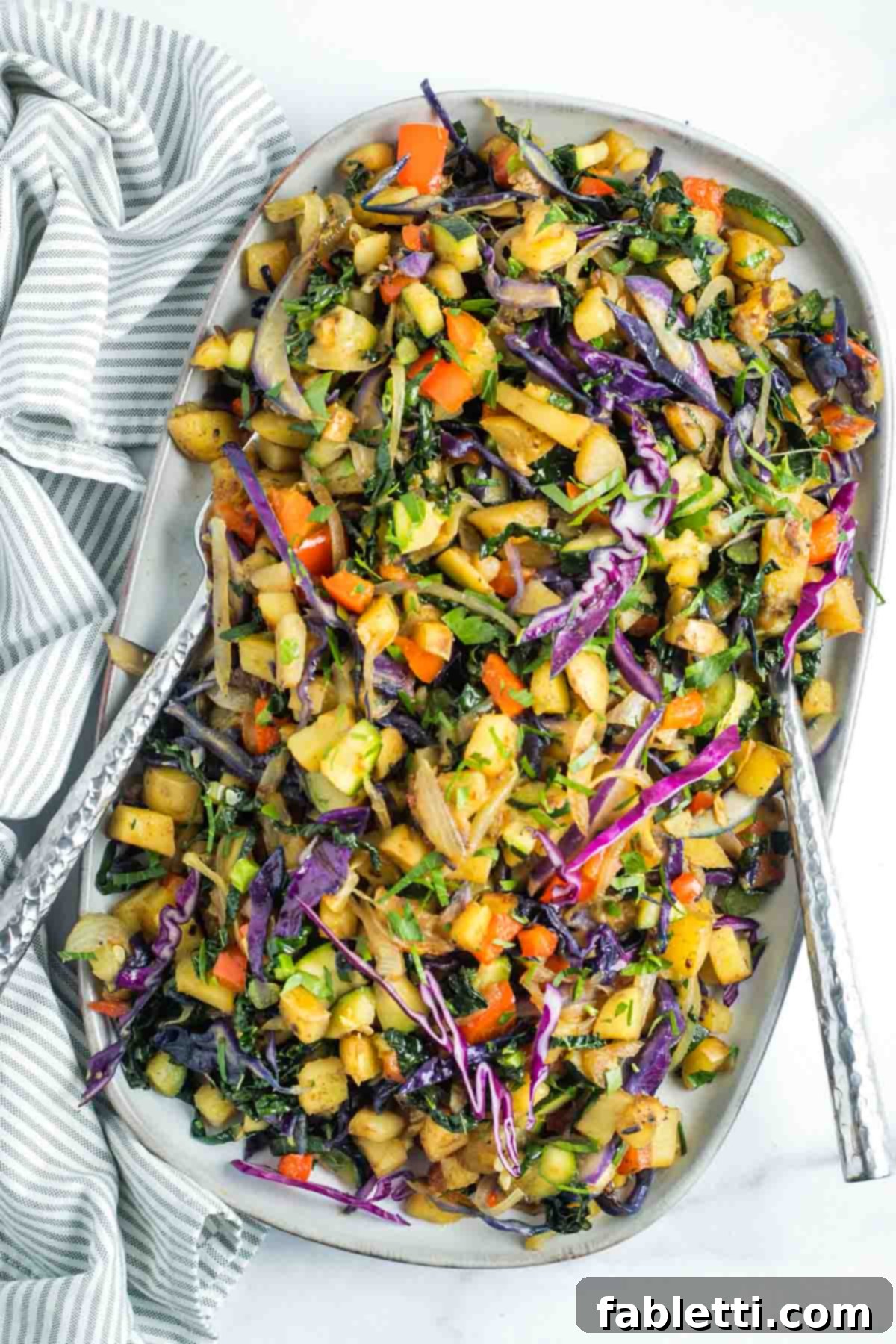
The Unmatched Versatility of Vegan Veggie Hash
One of the many reasons to adore this vegan potato and veggie hash is its incredible versatility. It’s not just a breakfast dish; it’s a meal prep champion that can be enjoyed warm, cold, or at room temperature. This flexibility makes it an ideal option for busy individuals and families seeking nutritious, delicious meals throughout the week. Reheating is a breeze, whether you prefer the stovetop or oven. A quick warm-up in a skillet will help re-caramelize those delightful potatoes and onions, bringing back their irresistible crispiness. Alternatively, pop it into a 350°F (175°C) oven for about 15 minutes until it’s perfectly heated through, ensuring every component is warm and inviting.
Beyond its easy reheating, this hash seamlessly integrates into various meals:
- A Hearty Vegan Breakfast or Brunch: Transform your morning by reheating the hash in a skillet over medium heat. Pair it with protein-rich additions like savory beans, tender lentils, or a fluffy scrambled tofu for a complete and energizing start to your day. It’s a fantastic alternative to traditional breakfast options and a surefire way to impress at brunch.
- A Zesty Lunch Upgrade: Say goodbye to boring lunches! Scoop a generous portion of this vibrant potato and veggie hash onto a simple green salad. The combination of warm, flavorful hash with cool, crisp greens creates a dynamic and satisfying meal that will keep you fueled and focused. It’s also excellent tucked into a wrap or served alongside a hearty soup.
- A Flavorful Weeknight Dinner Side: When dinner calls for something quick, easy, and undeniably tasty, look no further. This potato and veggie hash makes a phenomenal side dish for virtually any main course. It’s an effortless way to ensure everyone gets a substantial serving of vegetables without compromising on flavor. Serve it alongside grilled plant-based sausages, baked tempeh, or a simple roasted vegetable dish for a well-rounded meal.
- Embrace Your Crisper Drawer: This recipe truly shines as a “use what you have” meal. Don’t feel confined to the exact vegetables listed. It’s an excellent opportunity to clear out your crisper drawer! Incorporate whatever fresh vegetables you have on hand, including any leftover cooked veggies. This adaptability minimizes food waste and encourages culinary creativity, making it a sustainable and economical choice for your kitchen.
Essential Ingredients for Your Perfect Vegan Hash
Crafting the perfect vegan potato and veggie hash begins with selecting quality ingredients. Each component plays a vital role in creating the dish’s distinct flavor and texture. Here’s a closer look at what you’ll need and why:

- Potatoes: The foundation of any great hash! For the best results, opt for starchy or all-purpose varieties like Yukon Gold, Russets, or Idaho potatoes. These varieties crisp up beautifully on the outside while remaining tender and fluffy on the inside. If you’re looking to add a touch of sweetness and extra nutrients, sweet potatoes are also a fantastic substitute or addition, offering a delightful twist to the classic hash flavor profile.
- Kale: Lacinato kale (also known as dinosaur kale or Tuscan kale) is highly recommended for its tender texture and slightly less bitter flavor compared to curly kale. Its flat leaves are easiest to thinly slice, allowing it to wilt down perfectly and integrate seamlessly into the hash when heated. If Lacinato kale isn’t available, curly kale or even spinach could be used, though they might require slightly different cooking times.
- Cabbage: A heavy head of cabbage for its size usually indicates a more compact and fresh cabbage, which is ideal for slicing into thin, delicate ribbons. This ensures it cooks evenly and offers a satisfying, crisp-tender bite. While vibrant purple cabbage adds a beautiful pop of color to your dish, green cabbage works just as wonderfully and provides a similar delicious texture. Alternatively, cutting the cabbage into small cubes can also work if you prefer a different texture.
- Olive Oil: A good quality olive oil not only aids in sautéing but also imparts a rich, savory depth to the vegetables, especially helping the potatoes and onions achieve that coveted caramelized crispness. For those aiming for an oil-free hash, you can absolutely achieve this by using water or vegetable broth for sautéing. Be mindful that without oil, the potatoes and onions might not develop quite the same level of golden crispness, but the flavor will still be outstanding.
- Spices: This recipe embraces a warm and aromatic Mediterranean spice profile, featuring cumin, turmeric, and garlic powder. Cumin adds an earthy warmth, turmeric offers a subtle peppery note and a beautiful golden hue, and garlic powder provides a foundational savory flavor. However, don’t hesitate to customize! You could easily lean into a Mexican flavor profile with a homemade taco seasoning blend, or opt for an Italian blend with oregano, basil, and thyme for a different culinary journey. Experiment to find your favorite combination!
Mastering Vegetable Preparation for Your Skillet Hash
Effective vegetable preparation, or “mise en place,” is key to a smooth and successful cooking process. It ensures all your ingredients are ready when you need them, preventing last-minute rushes and uneven cooking. The golden rule for this hash is to chop all your vegetables and measure out your spices *before* you even turn on the stove. This not only streamlines the cooking but also helps you enjoy the process.
A crucial tip: save the potato cutting for last! Potatoes tend to oxidize and turn brown quickly once cut and exposed to air. If you need to chop your potatoes ahead of time, simply place the cubed pieces in a bowl of cold water. This prevents discoloration. Just remember to drain them thoroughly and pat them dry before adding them to your hot skillet to ensure they crisp up beautifully.
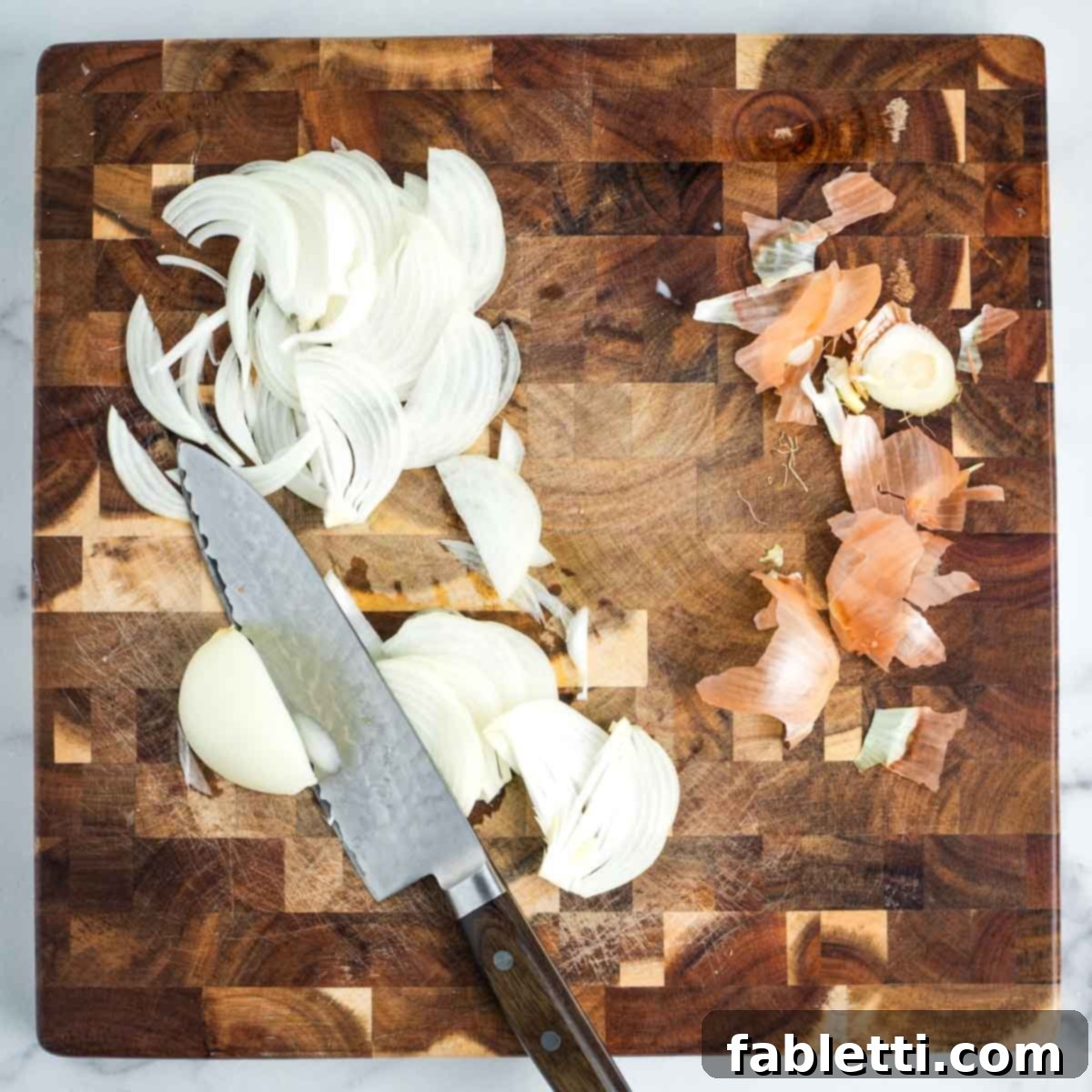
To prepare the onion, cut it in half through the stem end. Discard the outer skin and then place each half cut-side down on your cutting board. Using a sharp knife, carefully cut thin, uniform slices. Thin slices ensure the onion cooks down quickly and caramelizes nicely.
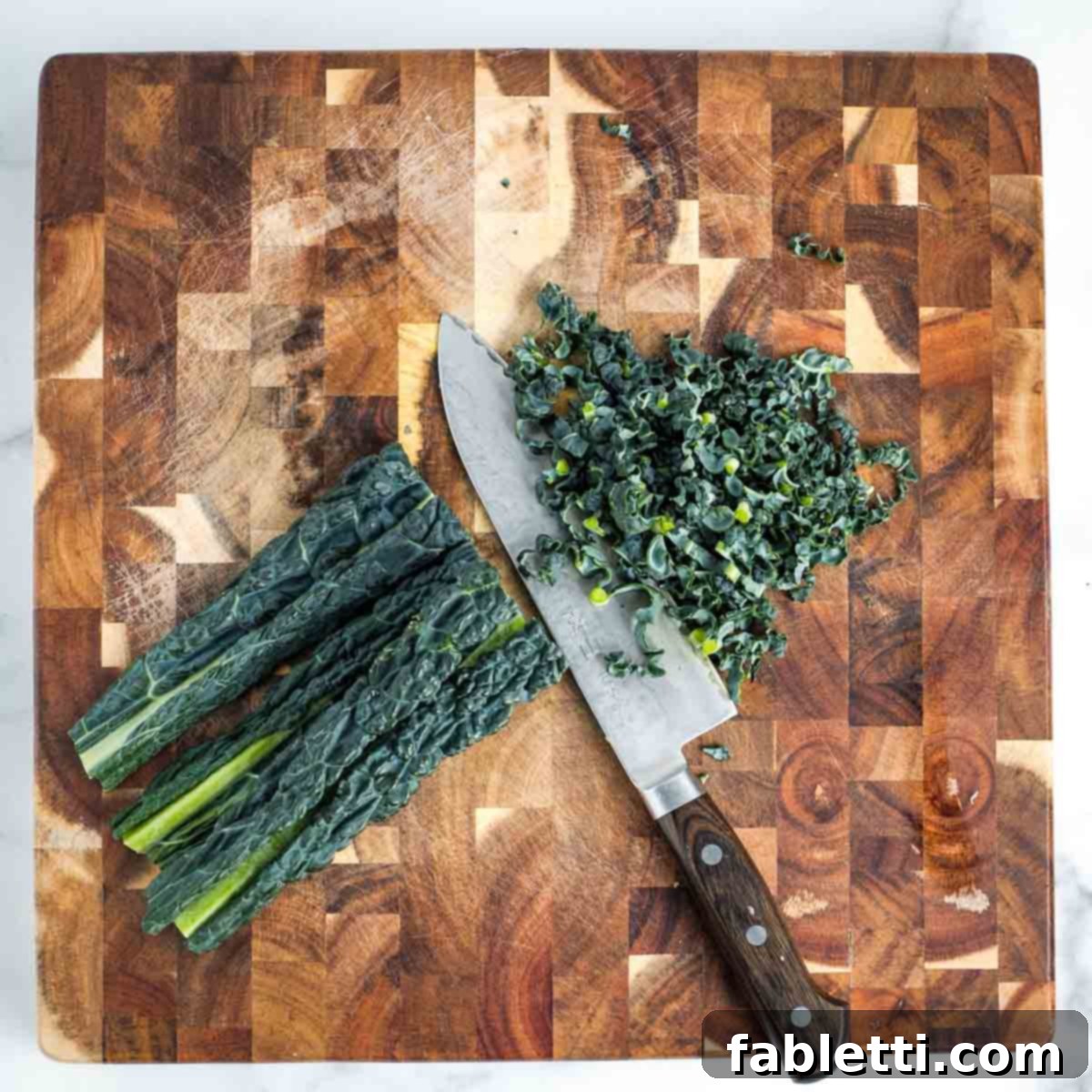
For the kale, wash the leaves thoroughly and pat them completely dry to prevent steaming in the skillet. Stack the clean, dry leaves one on top of the other, then roll them tightly into a cigar shape. Use a sharp knife to slice across the roll as thinly as you can, creating delicate ribbons that will wilt beautifully.
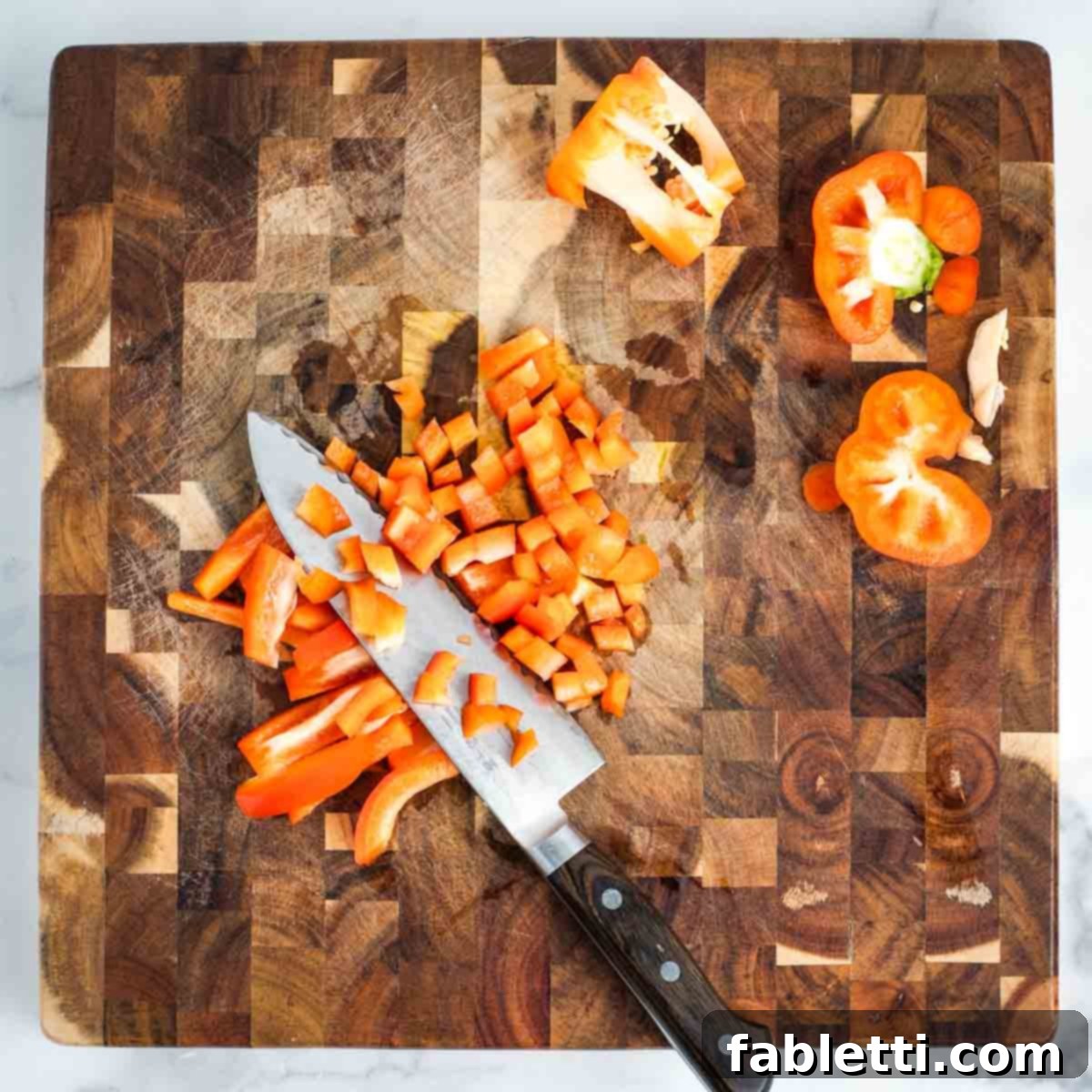
To dice the red bell pepper, start by cutting off both ends. Discard the inner core and seeds. Lay the pepper flat and cut it into thin strips, then rotate the strips 90 degrees and cut across them to create small, uniform cubes. Consistent sizing ensures even cooking.
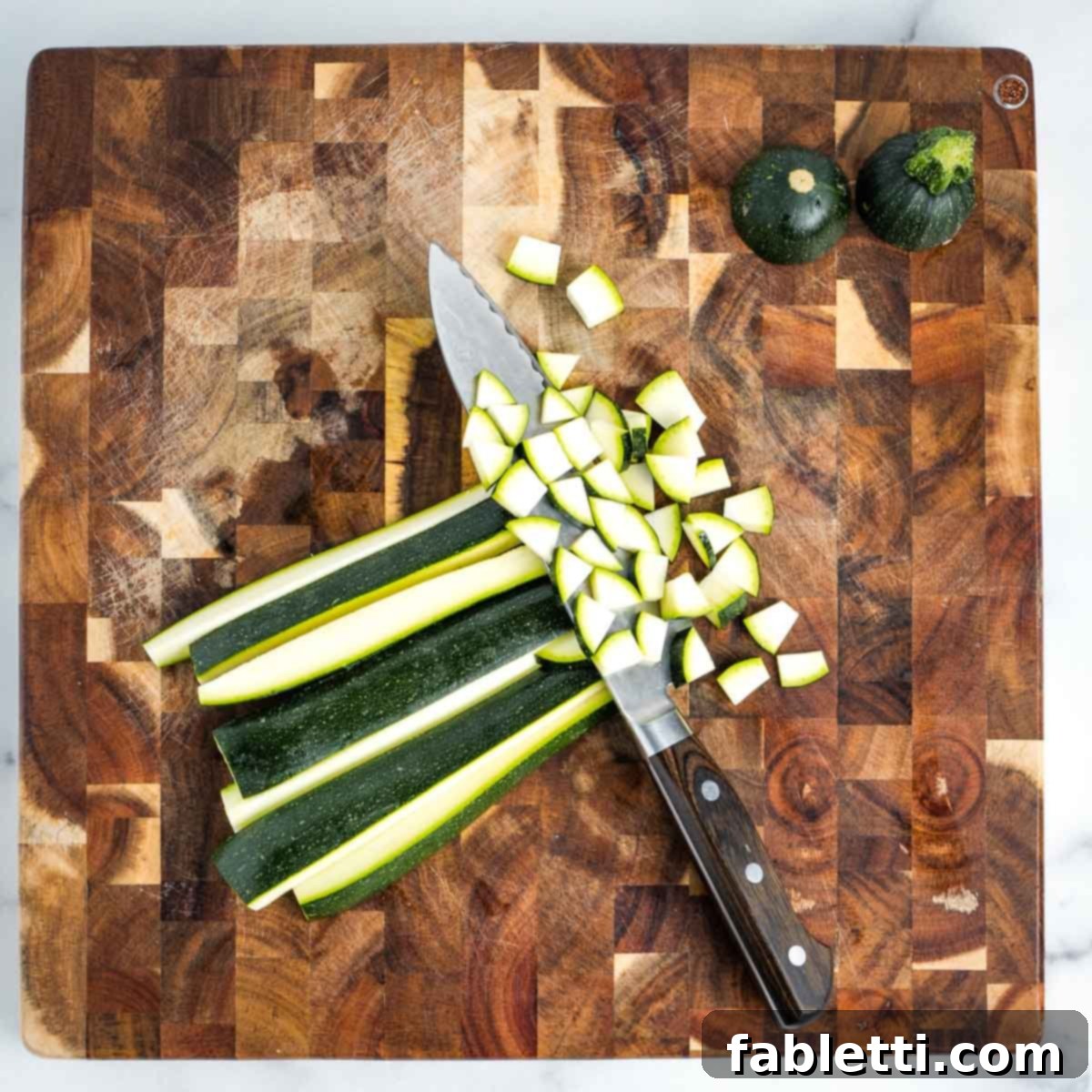
For the zucchini, slice off both ends. Cut the zucchini lengthwise into long strips, then stack those strips and cut across them to form small, even cubes. The smaller dice will ensure the zucchini cooks quickly and integrates well into the hash without becoming mushy.
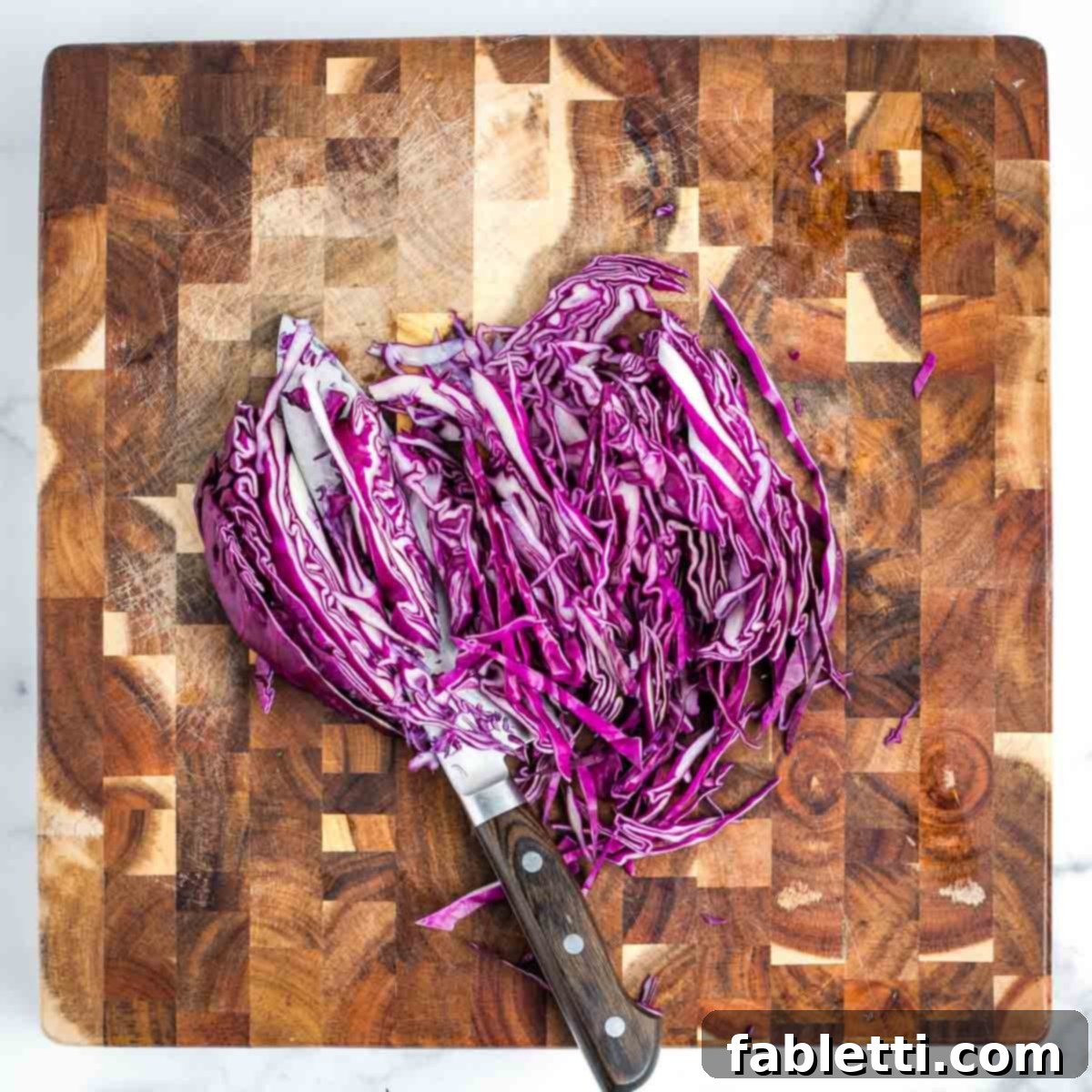
Depending on the size of your cabbage, use a quarter or an eighth of a head. If you’re pressed for time, pre-shredded cabbage from your local grocery store’s salad bar is a convenient option. Otherwise, lay the cut side down and slice it into very thin strips or ribbons. This cut allows the cabbage to soften quickly while still retaining a slight al dente crunch.

Finally, for the potatoes, wash and peel them (or leave the skin on for extra fiber and rustic charm). Slice them into thin rounds, then stack the rounds and cut them into strips, and finally, cut across the strips to create small, uniform cubes. The smaller and more consistent your potato dice, the quicker and more evenly they will cook, leading to that desirable crispy exterior and tender interior.
Creating Your Crispy and Flavorful Vegan Potato and Veggie Hash
With all your vibrant vegetables prepped and ready, it’s time to bring this delicious hash to life in a hot skillet. The key to a truly exceptional hash lies in building layers of flavor and texture, allowing each ingredient to develop its unique character.

Begin by heating a heavy skillet (cast iron works wonders here!) over medium-high heat. Once the skillet is visibly hot, swirl in your olive oil. Add the diced potatoes, stirring well to ensure each cube is evenly coated with the oil. Spread them into a single layer and resist the urge to stir for the next 2-3 minutes. This undisturbed cooking allows the potatoes to develop a beautiful golden crust and crisp texture – the start of true hash perfection.
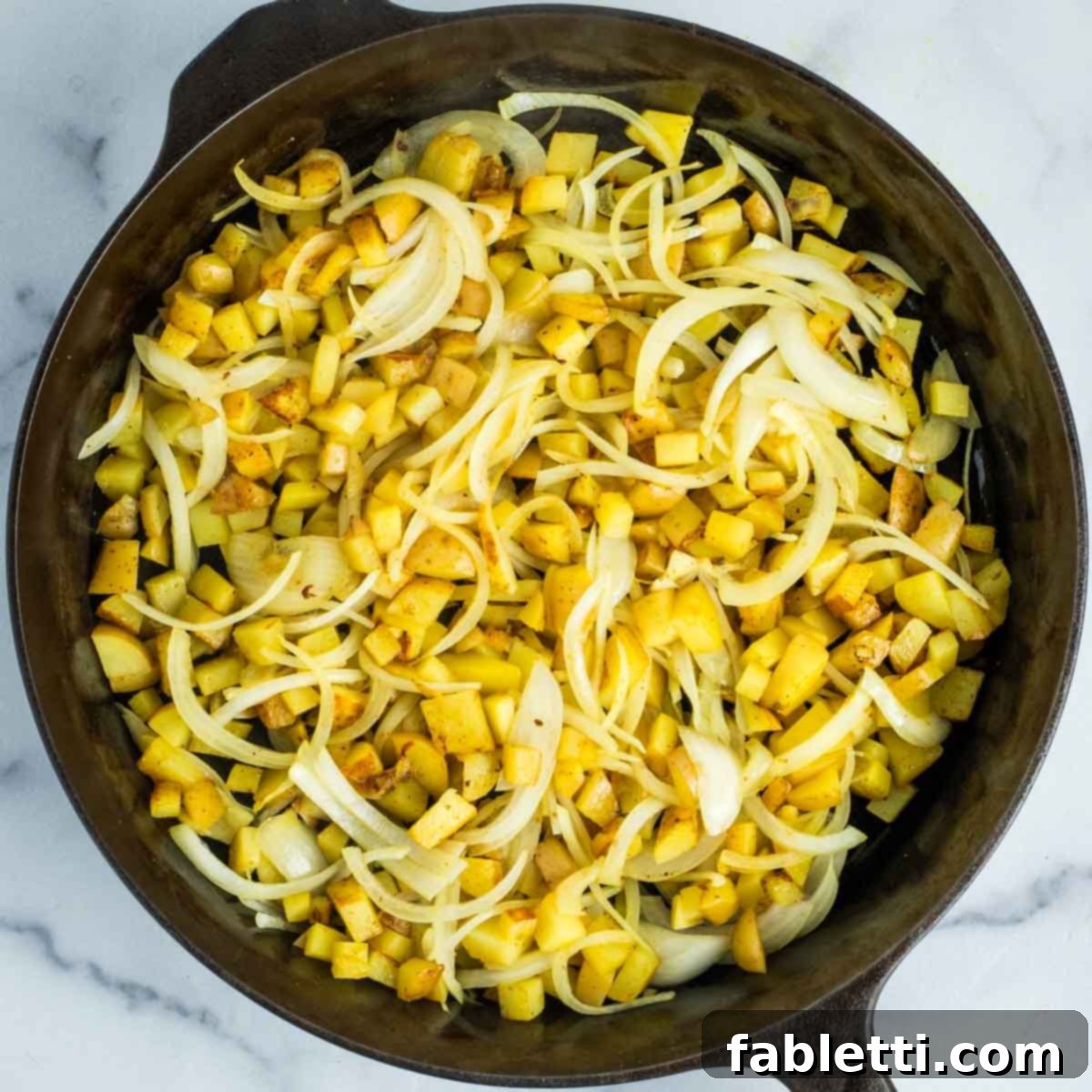
After the potatoes have begun to brown and crisp, add the thinly sliced onions to the skillet. Stir thoroughly to incorporate them with the potatoes and coat them in any residual oil. Again, allow the onions to cook undisturbed for a few minutes to encourage caramelization, which deepens their sweetness and flavor. If you notice the pan becoming too dry or ingredients sticking, add 1-2 tablespoons of water or vegetable broth, stirring just enough to release any stuck bits and re-moisten the pan.

Now, it’s time to introduce the softer vegetables and your aromatic spices. Place the chopped zucchini and bell pepper directly onto the potato and onion mixture. Evenly sprinkle your chosen spices – cumin, turmeric, and garlic powder – over the vegetables. The heat will immediately begin to awaken their fragrances, infusing the entire hash with their warm, earthy notes.
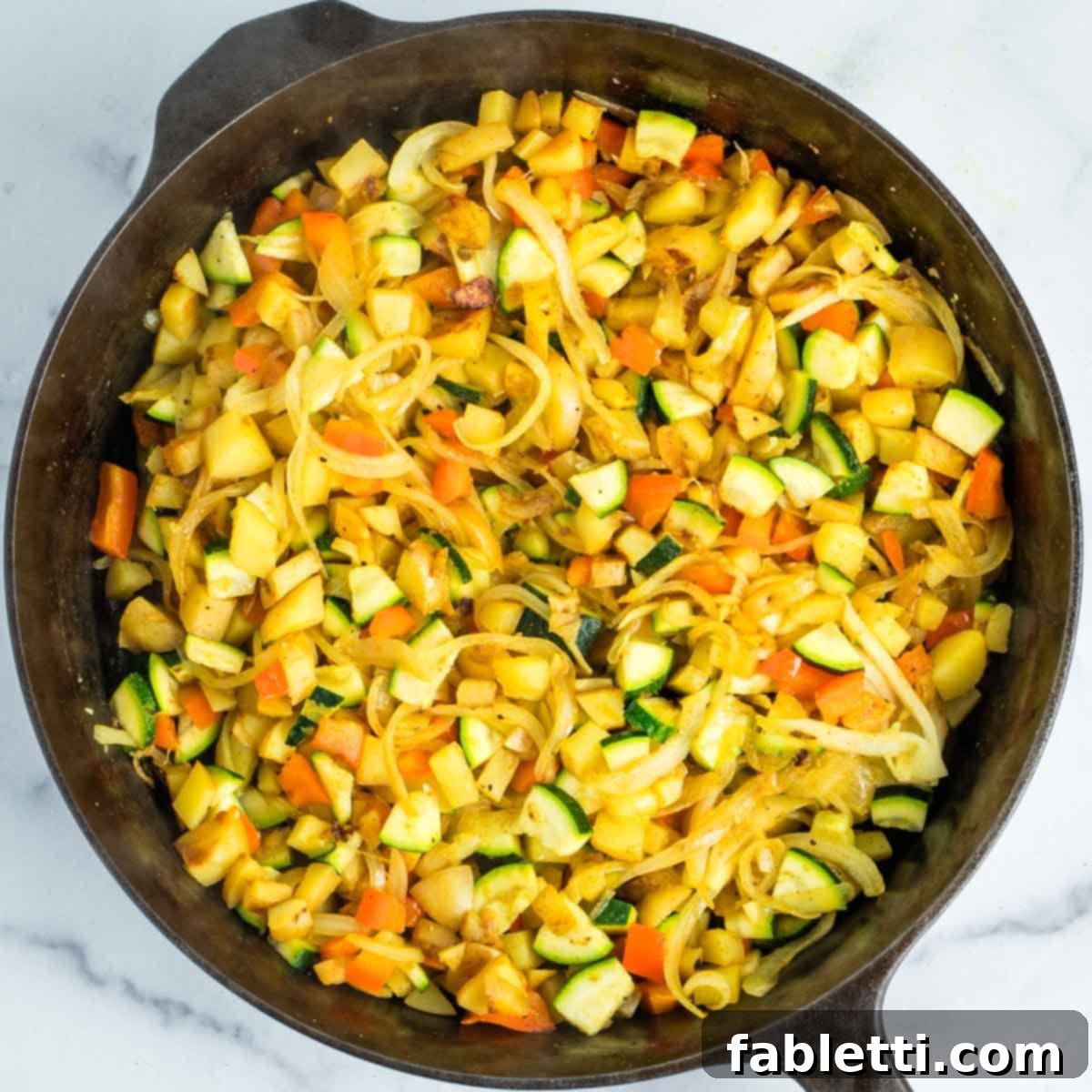
Mix all the ingredients well, ensuring the spices are evenly distributed and coat every piece of vegetable. Add another 1-2 tablespoons of water, if needed, to moisten the skillet and prevent any sticking, especially as the zucchini and bell pepper release their moisture. Allow this mixture to cook for another 2-3 minutes, stirring occasionally to ensure everything cooks evenly and to prevent any single ingredient from overcooking or burning.
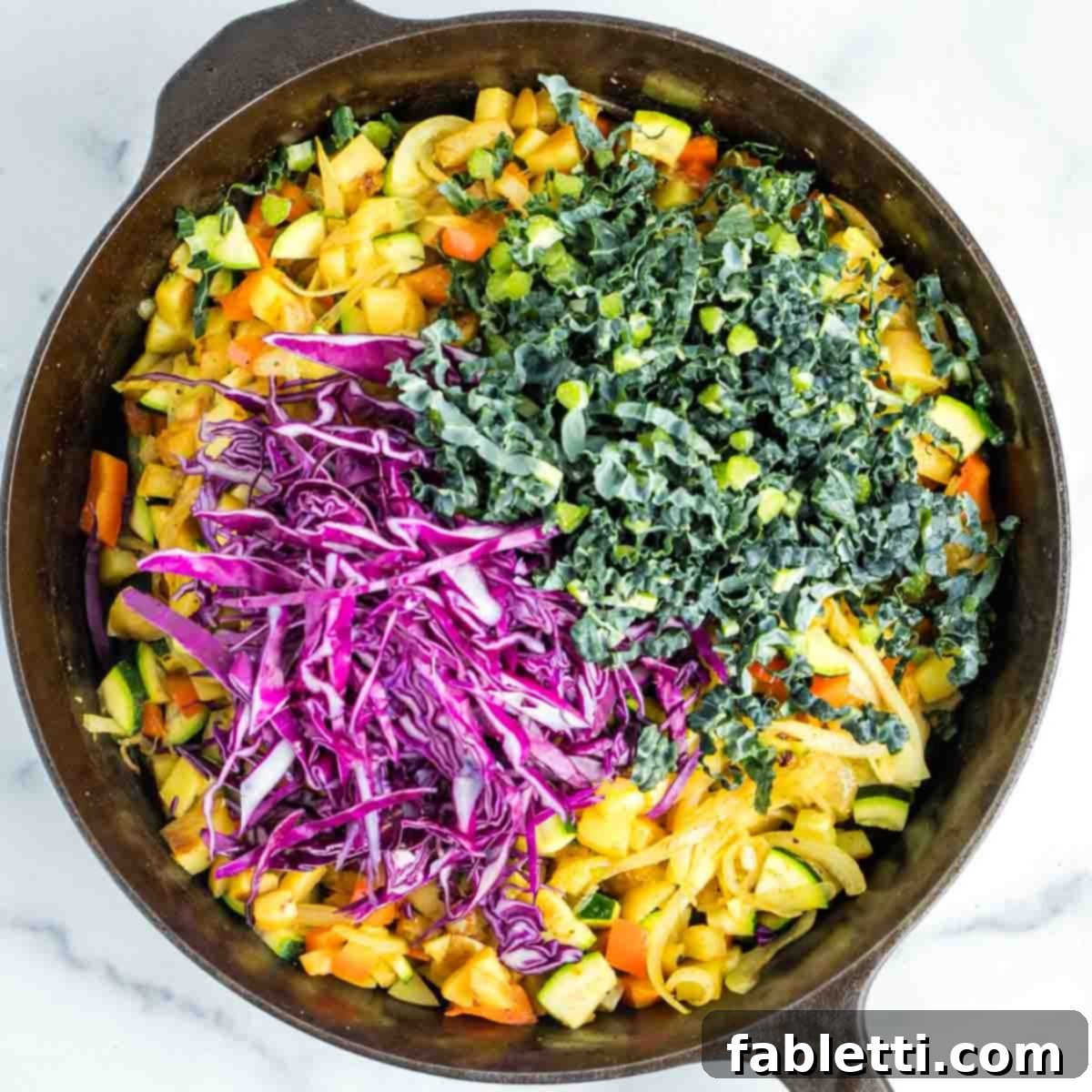
Finally, incorporate the delicate greens. Add the thinly sliced kale and cabbage to the skillet. Stir everything together. If the pan appears dry, add another 1-2 tablespoons of water. Continue to cook for just a few minutes, stirring gently, allowing the kale and cabbage to wilt down into the hash. You’ll notice their vibrant colors soften and their volume reduce as they cook. The goal is to achieve a tender-crisp texture for the cabbage and soft, palatable kale.

I personally prefer my cabbage to be more al dente, retaining a bit of its natural crunch for added texture. Therefore, once the kale has visibly wilted and the cabbage is tender-crisp, I turn off the heat immediately. Give the hash a final good stir. Now is the time for tasting and adjusting! Add more sea salt and freshly ground black pepper to taste. A sprinkle of fresh parsley or cilantro at the end adds a burst of freshness and visual appeal. Serve your magnificent Vegan Potato and Veggie Hash warm and enjoy!
Debra’s Pro Tips for the Ultimate Vegan Hash
Achieving a truly outstanding vegan potato and veggie hash goes beyond just following the steps. These expert tips from Debra will help you master the technique and create a hash that’s perfectly crisp, flavorful, and satisfying every time.

- Start with a Sizzling Skillet: The temperature of your skillet is paramount. Ensure it’s piping hot before you add any oil or ingredients. A hot pan creates an immediate sear on the potatoes and helps prevent sticking, leading to superior browning and crispiness. A cold pan will cause the potatoes to steam rather than fry, resulting in a soggy texture.
- Embrace the “Undisturbed Cook”: Patience is a virtue when cooking hash. After adding potatoes, and then subsequent vegetables, allow them to cook undisturbed for a few minutes. This crucial step is what allows the natural sugars to caramelize and the starches to crisp up, developing those irresistible browned bits that define a great hash. Resist the urge to constantly stir!
- Invest in the Right Tools: For the best results, a heavy-bottomed cast iron skillet is your best friend. Cast iron distributes heat incredibly evenly and retains it well, which is essential for consistent browning. Pair it with a sturdy, heavy metal spatula. This tool is perfect for scraping up any delicious browned bits from the bottom of the pan and for turning the hash effectively without breaking up the delicate potato cubes.
- Smart Hydration for Healthy Cooking: To avoid an overly oily dish, use water or vegetable broth strategically. Add 1-2 tablespoons of liquid as needed when the pan looks dry or if ingredients start to stick. This helps deglaze the pan, release flavorful browned bits, and prevent burning without adding unnecessary extra oil. It’s a healthier way to manage moisture and heat.
- The Potato Oxidation Secret: As mentioned, cut your potatoes just before you’re ready to cook them. This minimizes their exposure to air, which causes enzymatic browning. If you absolutely must prep them ahead, submerging them in cold water is a temporary solution. Just ensure they are completely drained and patted dry before they hit the hot oil.
- Boost the Umami Factor: If you’re aiming to cut back on breakfast meats but still crave that savory depth, consider adding thinly sliced shiitake mushrooms. Introduce them at the very beginning of the cooking process with the potatoes. As they cook down, shiitake mushrooms release a rich umami flavor and develop a satisfying, meaty texture that will elevate your hash and provide that hearty satisfaction without any animal products. Other mushrooms like cremini or oyster mushrooms also work wonderfully.
- Seasoning is Key: Don’t forget to taste and adjust your seasoning throughout the cooking process, especially at the very end. Different vegetables and spices require varying amounts of salt and pepper. A final taste test ensures your hash is perfectly balanced and bursting with flavor. A squeeze of fresh lemon juice at the end can also brighten the flavors beautifully.
- Storage and Reheating Made Easy: This hash is fantastic for meal prep! Store any leftovers in an airtight container in the refrigerator for up to 5-7 days. Reheat gently in a skillet over medium heat for 5-7 minutes, stirring occasionally until heated through, or in an oven at 350°F (175°C) for 10-15 minutes. It maintains its deliciousness, making healthy eating convenient.
Did you know commenting and rating recipes is one of the best ways to support your favorite food bloggers? If you enjoyed this recipe, please consider leaving a five-star rating and a comment below. We love hearing about your cooking experiences! Also, don’t forget to share your amazing photos on Instagram by tagging me @dkhealthcoach and using the hashtag #debraklein. Your support helps us create more delicious plant-based recipes for you!
📖 Vegan Potato and Veggie Hash Recipe

Vegan Potato and Veggie Hash
Debra Klein
Rate this Recipe
Pin Recipe
10 minutes
15 minutes
25 minutes
Breakfast & Brunch
American
6
121
kcal
Equipment
- Cast iron skillet
- Metal Spatula
Ingredients
Serving Size: 6
- 2 tablespoon olive oil
- 1 lb. yukon gold potatoes small dice
- 1 small onion sliced thin
- 1 small zucchini diced
- 1 red bell pepper diced
- ⅛ head of red cabbage
- 2 leaves lacinato kale sliced super thin
- ½ teaspoon cumin
- ½ teaspoon sea salt
- ¼ teaspoon garlic powder
- ¼ teaspoon turmeric
- ¼ teaspoon ground black pepper
- ½ cup water
Instructions
- Chop all veggies before you begin cooking. Remember to cut the potatoes last to prevent them from oxidizing and turning brown. For best results, cut the kale, cabbage, and onion into super thin strips, and the zucchini, bell pepper, and potatoes into small, uniform diced cubes.
- Heat a heavy skillet, preferably cast iron, over medium-high heat until it’s hot and shimmering.
- Add the olive oil to the hot skillet, then immediately add the diced potatoes. Stir well to ensure all potato cubes are evenly coated with oil. Spread them into a single layer and leave them undisturbed for 2-3 minutes, allowing them to brown and crisp up.
- Stir the potatoes, then add the thinly sliced onion into the pan. Stir again to coat the onion with any oil. Allow the onions to cook undisturbed for a few minutes to begin caramelizing. If the pan seems dry or ingredients start to stick, add 1 tablespoon of water and mix gently.
- Continue adding the remaining vegetables in the order of their cooking time: first the diced zucchini and bell pepper, then the cabbage, and finally the thinly sliced kale. After each addition, stir well to combine and spread the vegetables evenly. Allow them to cook undisturbed for a few minutes, adding 1-2 tablespoons of water as needed to keep the pan moist and prevent drying out.
- Add the spices (cumin, sea salt, garlic powder, turmeric, and black pepper) after adding the zucchini and bell pepper. Stir thoroughly to evenly distribute and coat all the vegetables with the aromatic blend. The entire cooking process, from potatoes to wilted greens, should take approximately 10-15 minutes.
- Once all the vegetables have been added and sufficiently cooked to your desired tenderness (I prefer cabbage al dente!), turn off the stove. Mix well one last time. Taste for seasoning, adding more salt, pepper, or a squeeze of fresh lemon juice if desired. Sprinkle with fresh herbs like parsley or cilantro and serve warm immediately.
- Store any leftover hash in an airtight container in the refrigerator for up to a week. To reheat, gently warm in a heavy skillet on the stovetop for less than 5 minutes until heated through, or bake in a 350°F (175°C) oven for 10-15 minutes.
Notes
Nutrition
Carbohydrates: 18g
Protein: 3g
Fat: 5g
Saturated Fat: 1g
Polyunsaturated Fat: 1g
Monounsaturated Fat: 3g
Sodium: 209mg
Potassium: 491mg
Fiber: 3g
Sugar: 3g
Vitamin A: 1226IU
Vitamin C: 58mg
Calcium: 36mg
Iron: 1mg
Note
The nutrition calculations were done using online tools. To obtain the most accurate representation of the nutritional information in any given recipe, you should calculate the nutritional information with the actual ingredients you used. You are ultimately responsible for ensuring that any nutritional information is accurate, complete and useful.
Did you make this recipe? Please leave a review below, then snap a picture and tag me @dkhealthcoach or use hashtag #dkhealtcoach on Instagram so I can see it!!
